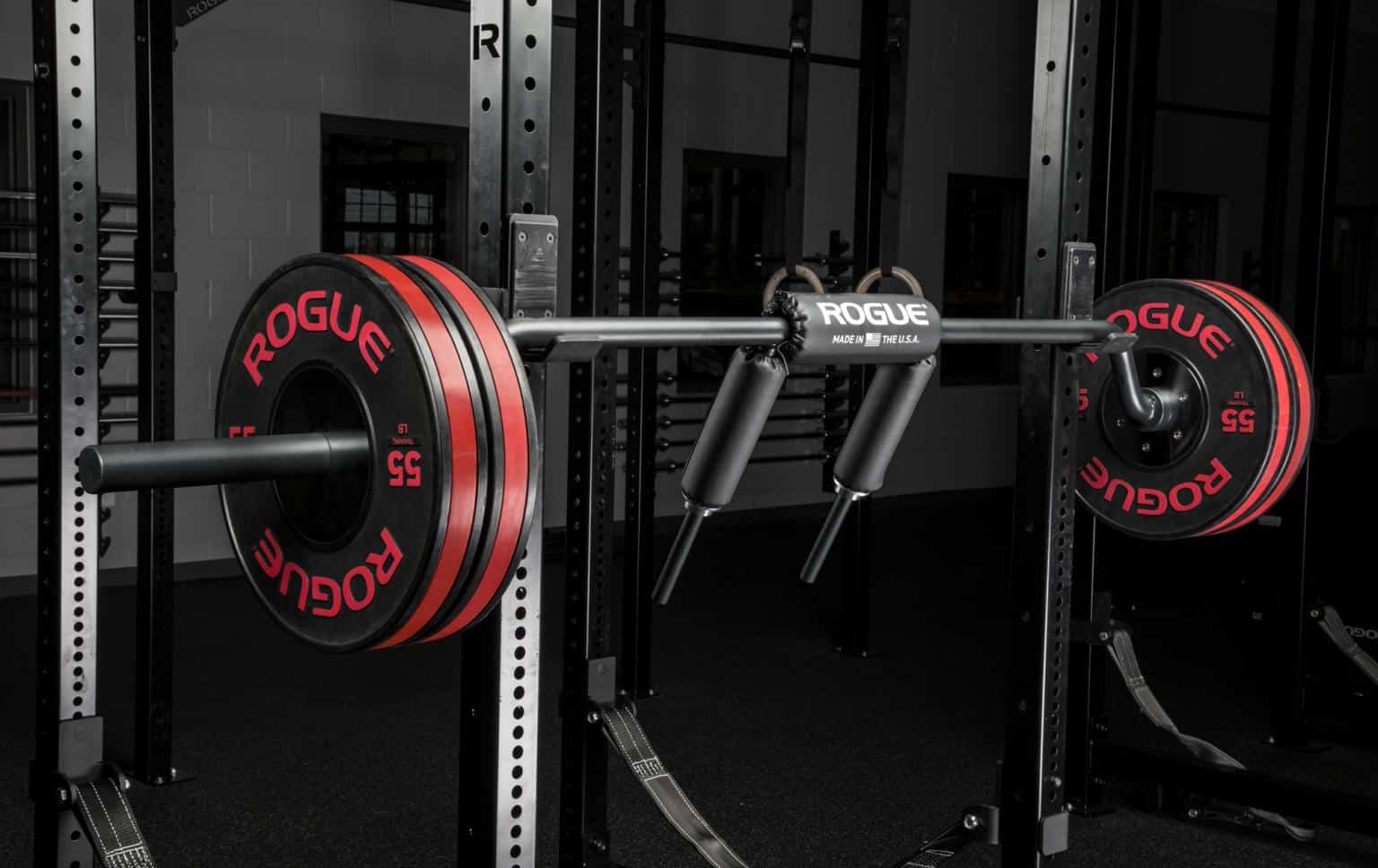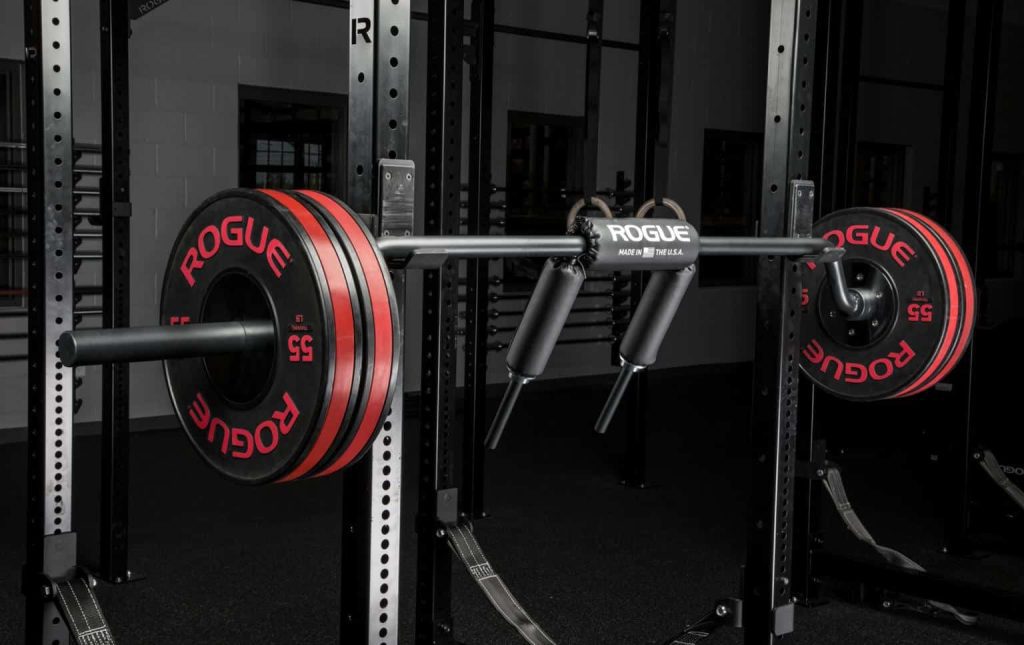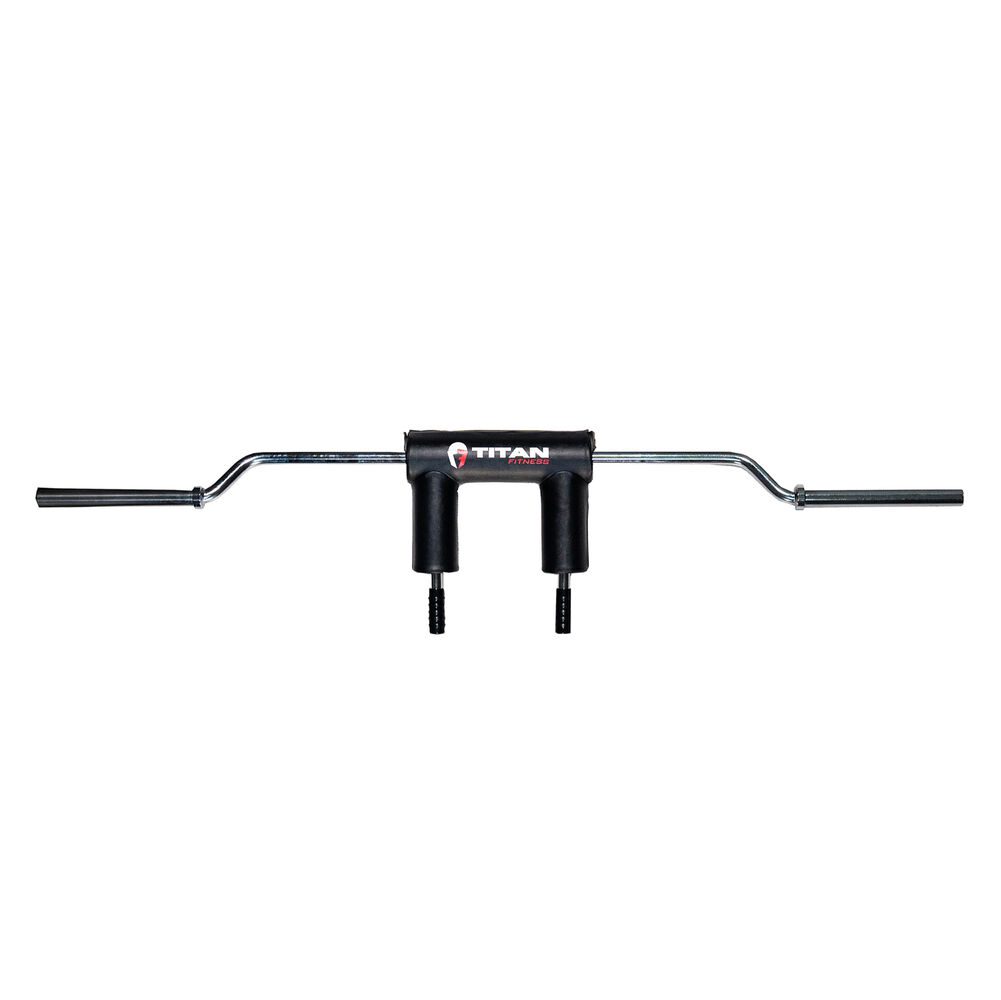Purchasing a safety squat bar is quickly becoming a popular option for home gym owners.
That’s because the best safety squat bars give you a different training stimulus than a barbell front or back squat. It’s also safer for people with poor upper body mobility and could even be advantageous for seniors trying to gain strength or add muscle.
Here are some reasons you should own one, and some safety squat exercises to help you get started.
What Is a Safety Squat Bar, and Who Is It For?
Made popular by powerlifters, the safety squat bar is a modified barbell with handles in the front (referred to as ‘cambers’), which allows athletes to secure the bar on their back without reaching back or holding the bar in a front rack position.
You can find safety squat bars as low as 45lbs, but you’ll often find ones weighing 65 to 70lbs. Heavier safety squat bars are better if you’re strong and able to lift at least a moderate amount of weight (say 225lbs or more)

Benefits of Using a Safety Squat Bar (SSB)
- Being able to change the angle of your torso during a squat, which works muscles differently
- Being easier to secure the bar on your back if you have bad mobility or injuries
- Good for mimicking both the low bar squat and high bar squat
- Having a great tool for strength training accessory work
Powerlifters, Strongman competitors, people with poor shoulder mobility, seniors, and people recovering from injuries can all benefit from using the safety squat bar during training.
It’s another specialty bar (like the transformer bar, yoke bar, or hex bar) that can take your gains to the next level.
Key Differences Between a Barbell and a SSB for Squat Exercises
The major training difference between a safety squat bar and a barbell is the loading angle on your back. The pointers below will help you see the difference.
Barbell Front Squats
- Require upper body flexibility (in shoulders and wrists especially)
- Require active thoracic extension during the movement (you can’t relax or you’ll drop the bar)
- More vertical torso angle during squats (works your legs more and your core less)
Barbell Back Squat
- Requires upper body mobility in the shoulders, arms, and upper back
- More angled torso during squats, which puts pressure on your back and core
- Traditionally, athletes can lift more weight than they can on a front squat
Safety Bar Squat
- Upper body mobility and extension is less necessary (although you can activate your arms if you want by pushing upward on the handles)
- Activates the upper back, which can help strengthen and build stability
- Torso angle more closely mimics front squats, which takes pressure off your back and core
- Upright torso angle prevents you from lifting as much as with a straight bar back squat (approximately 10 percent less)
Proper Form When Using a Safety Squat Bar
Setup
- Stand in front of the rack where you’ll be taking the barbell out (always walk a bar backwards out of the rack so you can return it stepping forward)
- Optional: Place a box behind you to squat to. This is good for powerlifting accessory work or if you need a physical cue to see how low to go at first.
- Place your hands on the handles; come underneath the bar and rest it on your shoulders.
- Turn the handles upwards as you stand; they should be pointing in front of you instead of facing the ground
Performance
- Set up like you would for a regular back squat; weight in your heels, tight upper body.
- Kick the hips back to the wall behind you; allow your knees to bend as you drop down into a squat.
- When you get to parallel (thigh is parallel with the floor) press through your heels to stand back up.
- Repeat. Make sure to inhale each time you come up and exhale as you push through each rep.

Key Features to Look for Before Purchasing
Sold on getting a safety squat bar for your home gym? If so, there are some things to keep in mind when you shop.
- Bar Weight. While you can find some 45lb safety squat bars, a 65 or 70lb product is more durable and can hold more weight. Unless it’s totally out of your price range or you simply prefer the 45lb, it’s best to get a heavier bar.
- Durability. Buy from a reputable dealer to avoid getting something that will fall apart in a few years.
- Shipping Method. Some safety squat bars come in 2 or 3 pieces and must be assembled. Others come already welded together.
- Price. You’ll pay between $250 and $500 for your bar. You never want to skimp on a product that will be holding heavy weights on your posterior chain, but still aim to get the best gear you can for your budget.
- Color. You’ll find chrome, matte black, and shiny black options from the reputable SSB dealers. Go with the one you like or that matches your home gym’s decor.
- Pad Quality. Check out the reviews. Gym equipment with pads are notorious for ripping at the seams or falling apart after a few months. You want a set with quality pads and/or a warranty.
- Warranty. Some products offer 1 or 3 year warranties. Others offer a lifetime warranty. Understand what type of warranty you’re purchasing first.
Safety Squat Bar Reviews – Which is the Best for You?
Below are some of the safety squat bars we recommend.
| Image | Product | |
|---|---|---|
A known and proven commodity
| Rogue SB-1 Safety Squat Bar
| View on Rogue Fitness |
Budget safety pick
| PopSport Olympic Safety Squat Bar
| View on Amazon |
Pound for pound best value
| Titan Safety Squat V2
| View on Titan Fitness |
The original
| EliteFTS SS Yoke Bar
| View on EliteFTS |
Best for novice weightlifters
| Sorinex Safety Squat Bar
| View on Sorinex |
Most Popular Exercises with an SSB
Ordered your SSB? Great! Here are some killer exercises you can try when it arrives.
1. Safety Bar Back Squat
See the cues or watch one of the videos above for mastering the SSB Squat. Safety bar back squats are a fantastic way to build lower body strength on your off days. They can also be used as a standalone exercise if you’re injured or tight.
2. Safety Bar Zercher Squats
To do Zercher squats with an SSB bar, set the pins up in your cage at about belly button level. If you have catch straps or Oly blocks, you can use those instead.
When you drop under the SS bar, grab onto the handles
- Set up in the bottom of a squat underneath the safety squat bar; place the crook of your elbows on the barbell.
- Squeeze your hands towards your shoulders to create tension (bringing the knurled handles towards your face); press up through your heels to stand.
- Lower gently, without banging the weight, then repeat.
3. Safety Bar Good Morning
- Bring the bar off the pins like you would for a back squat.
- With a tight back and neutral spine, kick your hips backwards and allow your torso to come forward-slow and controlled.
- When you feel tension in your hamstrings, stop; go back where you came from.
- Repeat.
Over time, work your way up to folding your body to a 90-degree angle. The SSB should be plenty of weight when you first start.
4. Safety Bar Reverse Lunges
- Bring the bar out of the rack like you would a back squat; take two or three full steps back to give yourself space.
- Drop your right knee behind you into a lunge; allow your left knee to bend as you lower to the floor.
- Gently touch your knee on the ground; both knees should be at a 90-degree angle and your torso should be upright.
- Press through your heel to stand.
Repeat on the other side.
5. Safety Bar Split Squat
Make sure you have three to five feet of space behind the pins so you can walk backward and not trip over any garage gym equipment. This is a great glute exercise!, then switch to the other side.
- Take the bar out of the rack like with a back squat; take a few steps backward.
- Bring your right leg behind your body approximately 2 feet.
- Drop your right knee down to the ground gently; drive through heel on your front left leg with the SSB bar on your back to stand.
- Repeat the desired number of repetitions then repeat on the other side.
Conclusion
Safety squat bars are a great way to mix up your strength training or give your upper body a break. If you’ve got a history of mobility issues, lingering injuries, or just want a new piece of equipment for your home gym to move weights with, give it a shot.
The Titan Safety Squat V2 is the best pound-for-pound bar in our reviews. The Rogue Fitness SSB is rated for over 1,000lbs if you lift on the heavier side. These are two of the best products you could choose.
Check out the rest of our fitness review guides for your strength training needs!
Insert Content Template or Symbol






